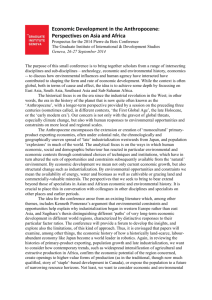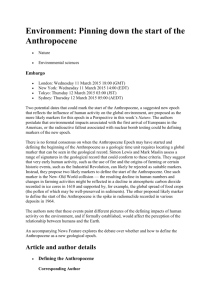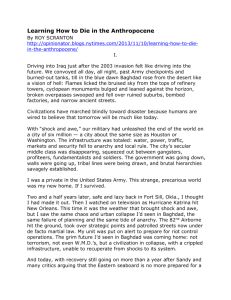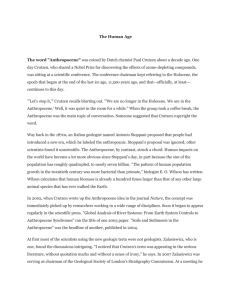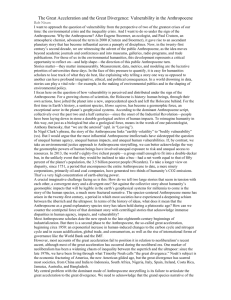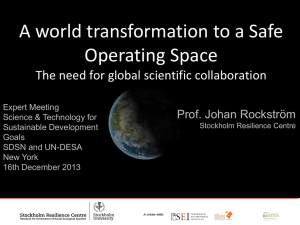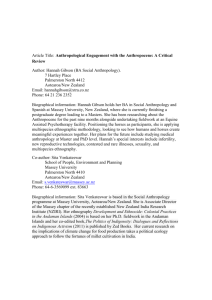Welcome to the Anthropocene
advertisement
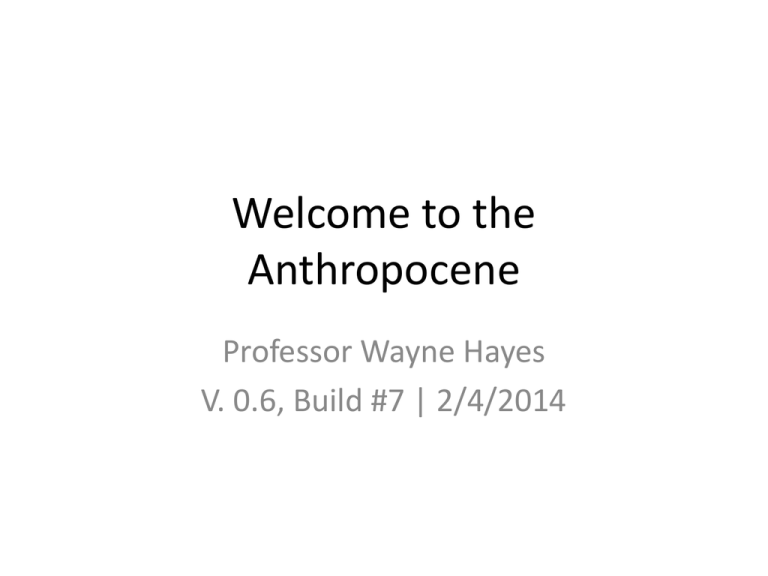
Welcome to the Anthropocene Professor Wayne Hayes V. 0.6, Build #7 | 2/4/2014 Our article is: “The Anthropocene: Are Humans Now Overwhelming the Great Forces of Nature?” Ambio , Vol. 36, No. 8, December 2007 ©Royal Swedish Academy of Sciences 2007 http://www.ambio.kva.se The article has become a classic and has taken on a large following. The notion of the Anthropocene has stuck. 4/10/2015 2 The authors are: • Will Steffen is the Director of the Fenner School of Environment at the Australian National University, Canberra. • Paul J. Crutzen won the Nobel Prize in Chemistry in 1995. He is Professor at the Scripps Institute of Oceanography and was formerly Director of the Max Planck Institute for Chemistry. • John R. McNeil is Professor of History at Georgetown and formerly held the Cinco Hermanos Chair in International and Environmental Affairs. Note: None of the authors are geologists. Each author is highly respected, comprising a formidable interdisciplinary team. 4/10/2015 3 Are we in the Anthropocene? 4/10/2015 4 How did we get there from here? 4/10/2015 5 What are the implications? 4/10/2015 Shanghai, 2007 (National Geographic) 6 From One Earth to One World: This phrase, the subtitle of the Brundtland Commission Report, Our Common Future, implies that: • The two images of Earth, one rooted in nature and the other in global economic society, must be reconciled. • This broadly defines the challenge of World Sustainability. 4/10/2015 7 The abstract from the original: 4/10/2015 8 Try another definition: "A period marked by a regime change in the activity of industrial societies which began at the turn of the nineteenth century and which has caused global disruptions in the Earth System on a scale unprecedented in human history: climate change, biodiversity loss, pollution of the sea, land and air, resources depredation, land cover denudation, radical transformation of the ecumene, among others. These changes command a major realignment of our consciousness and worldviews, and call for different ways to inhabit the Earth.“ (Emphasis added; source, A Cartography of the Anthropocene, viewed on 9/9/2012) 4/10/2015 9 The article’s first two paragraphs frame the challenge. • Human-induced change raises disturbing questions about the future of Earth and the environmental services that support human civilization. • They ask: Has the Earth left the benign interglacial state of the Holocene to enter a new era of Earth history, the Anthropocene? • They assert: “The Earth is rapidly moving into a less biologically diverse, less forested, much warmer, and probably wetter and stormier state.” • This “represents a profound shift in the relationship between humans and the rest of nature.” 4/10/2015 10 Before the Anthropocene: • The Agricultural Revolution began 10,000 to 12,000 years ago. Humans domesticated animals and plants, cleared forests, and discovered fire. Humans did not yet possess the technology or organization to dominate nature above a transitory regional level. • About 10,000 years ago, written language allowed the “accumulation of knowledge and social learning,” which the authors describe as “an impressive catalytic process”. 4/10/2015 11 The origins of the Anthropocene I: The Industrial Era (ca. 1800-1945) 1. 2. 3. 4. The Industrial Revolution The widespread use of coal (fossil fuels) The expansion of economic society Human population expands from about 750 million to about 2.5 billion. Note the emphasis on economics and not demography: Population growth follows economic growth. 4/10/2015 12 Note the importance of energy: 4/10/2015 13 The Anthropocene II: The Age of Acceleration (1945-ca. 2015) “This first stage of the Anthropocene ended abruptly around 1945, when the most rapid and pervasive shift in the human-environment relationship began.” This is also the advent of the USA as a world military, economic, and cultural power. 4/10/2015 14 An inflection point starts around mid-20th century. The Age of Acceleration starts soon after World War II, in 1950 with the USA as its epicenter. This historical observation initiates much of what unfolds in our course. 4/10/2015 15 Age of Acceleration: 4/10/2015 16 Examine indicators of the Anthropocene: 4/10/2015 17 See the original report for indicators. See especially table 1 and figure 2, page 617 of the original article on the Anthropocene. 4/10/2015 18 Anthropocene III: Stewards of the Earth (ca. 2015-?)? “Humankind will remain a major geological force for many millennia, maybe millions of years, to come. … Can humanity meet this challenge?” 4/10/2015 19 Humanity is becoming aware by these means: 1. Research, particularly on “interdisciplinary work on human-environment systems” 2. The Internet as “a global self-organizing information system” 3. The spread of free and open societies 4. Democratic political systems and the emergence of civil society. 4/10/2015 20 Three paths are open. 1. Business as usual 2. Mitigation 3. Geo-Engineering We need to examine them and perhaps go even further, regarding the challenge as an opportunity. 4/10/2015 21 Consider a fourth path: social ecology The Institute for Social Ecology considers social ecology to be: 1. A coherent radical critique of contemporary social, economic, political, and anti-ecological trends; 2. A democratic path toward reconstruction based on the convergence of small-scale, decentralized communities and bio-regions around appropriate technology and ethical social relations. This is called re-inhabitation. 4/10/2015 22 The business as usual scenario: Stated as: “…the institutions and economic system that have driven the Great Acceleration continue to dominate human affairs.” This assumes: 1. Human-driven changes will not disrupt the global economy or societies. 2. Economic society (“market-oriented economic system”) can adapt adequately. 3. The resources are available to mitigate damage. 4/10/2015 23 The risk to business as usual: “The long-term momentum built into the Earth System means that by the time humans realize that a business-as-usual approach may not work, the world will be committed to further decades or even centuries of environmental change. Collapse of modern, globalized society under uncontrollable environmental change is one possible outcome.” 4/10/2015 24 The authors do not express optimism: They note that “the Great Acceleration has considerable momentum and appears to be accelerating.” They conclude: “The critical question is whether the trends of dematerialization and shifting societal values become strong enough to trigger a transition of our globalizing society to a more sustainable one” 4/10/2015 25 The mitigation scenario involves: • • • • Improved technology and social organization Wise use of resources Control of human and animal population Conservation and restoration of the environment 4/10/2015 26 The authors stress dematerialization: Technology and economic development is essential. “Over the past several decades rapid advances in transport, energy, agriculture, and other sectors have led to a trend of dematerialization in several advance economies. The amount and value of economic activity continue to grow but the amount of physical material flowing through the economy does not” (619). 4/10/2015 27 Energy is important in the mitigation scenario. “In addition to the many opportunities for energy conservation, numerous technologies --from solar thermal and photovoltaic through nuclear fission and fusion to wind power and biofuels from forests and crops --- are available now or are under development to replace fossil fuels” (619). 4/10/2015 28 The geo-engineering scenario: Essential to this scenario is sequestration of carbon dioxide in underground reservoirs. Another technology is the release of aerosols to reflect the sun’s rays in the stratosphere. 4/10/2015 29 A warning about the geo-engineering scenario: Geo-engineering carries risks of unintended consequences and is subject to intense ethical debate. They warn that the cure could be worse than the disease. 4/10/2015 30 The conclusion issues a warning. The final paragraph states that the Great Acceleration is approaching a critical stage. The authors conclude: “Whatever unfolds, the next few decades will surely be a tipping point in the evolution of the Anthropocene.” What do you think? 4/10/2015 31 My expansion on the theme of the Anthropocene Anthropocene ==> Technosphere ==> Noosphere 4/10/2015 32 The article explains the Noosphere: 4/10/2015 33 From Anthropocene to Noosphere The teleology, or end point, of the biosphere was to provide the physical conditions for the ultimate destination of evolution, the transformation of the biosphere into the noosphere. Just as the biosphere transformed the earlier geosphere, the noosphere would transform the biosphere, extending the culminating destiny of humanity. (From W. Hayes, The Noosphere.) 4/10/2015 34 Vernadsky, Russian geographer and cosmologist stated in 1929: “The biosphere is the cradle of the noosphere.” 4/10/2015 35 From Teilhard de Chardin In 1926, Vernadsky met Teilhard de Chardin, a paleontologist and a Jesuit priest. Chardin had speculated about a global transformation, the noosphere. See Social Values and Social Progress, 4/10/2015 36 To be continued! My intention in this presentation is simply to connect the Anthropocene to the Technosphere and then to the Noosphere. This will be continued later. 4/10/2015 37
